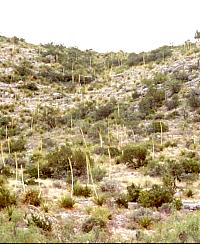
The towering flower stalks of the
sotol plant are a common sight in the Lower Pecos Canyonlands. Sotol
prefers thin rocky soils and steep terrain and often
grows in great abundance in such areas. Prehistoric
peoples harvested sotol hearts or "cabezas" (heads) in quantity and baked them in earth ovens. Photo
by Phil Dering.
Click images to enlarge
|
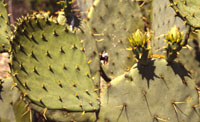
Prickly pear cactus was used for
many purposes. The young pads (nopalitos) are edible
with minimal cooking, as are the ripe fruits (tunas).
The larger pads were used to line earth ovens to provide
moisture and keep dirt off the baked goods. Large pads
were also split open or hollowed out and used as containers.
Photo by Phil Dering.
|
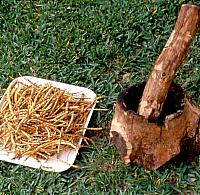
Mesquite beans ripen in the late
summer and are an excellent carbohydrate source. They
require minimal cooking, but preparing the beans is
a time consuming process. The beans must be gathered
before animals can devour them and then allowed to dry
thoroughly. Dried, they must first be torn by hand into
small pieces and then pounded until the tough, almost
unbreakable, seeds can be removed. The seedless pod
fragments are then pulverized into a fine powder that
can be stored or used in a variety of ways. Photo by
Phil Dering.
|
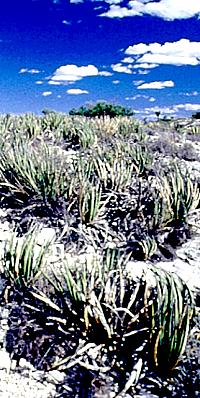
Lechuguilla stand growing in rocky
"soil." Photo by Phil Dering.
|
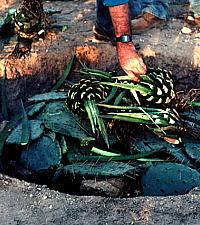
Trimmed lechuguilla hearts are placed
on top of a layer of prickly pear pads in this experimental
oven. Beneath the pads are hot rocks. The pads protect
the lechuguilla from burning and add moisture. The lechuguilla
hearts will be covered with more prickly pear pads and
then a thick layer of earth. The steamy heat inside
will slowly cook the lechuguilla and break down complex,
inedible carbohydrates into simple sugars. Photo by
Phil Dering.
|
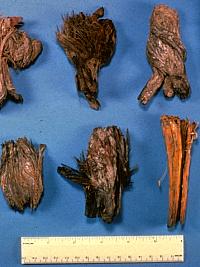
Quids, chewed lechuguilla and sotol
leaves, were found in large numbers in Hinds Cave. Lower
Pecos peoples chewed on the lower part of the baked
leaves until all the sugary carbohydrates were gone
and then discarded the leftover fibrous quids. Photo
by Phil Dering.
|
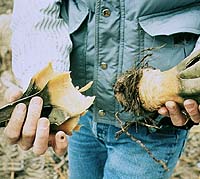
The edible parts of a baked lechuguilla
heart, like that of an artichoke, are the lower parts
of the inner leaves and the base of the plant to which
the leaves are attached.
|
|
The basic economy of the Lower Pecos Canyonlands throughout the prehistoric era was hunting and gathering
(also called foraging). Although hunting may have been the
emphasis during intervals when bison were present in the region,
as the Bonfire Shelter example clearly shows, plants probably
played a much greater role in the day-to-day survival. The
rich archeological record of the region has provided much
data for the reconstruction of prehistoric hunter-gatherer
economy in the region. The economy of the Archaic period has
been studied through the analysis of many different kinds
of materials including animal bones, plant remains, coprolites,
and human skeletal remains.
What we think of as the characteristic Archaic
economy of the Lower Pecos Canyonlands began developing at least as early
as the Late Paleoindian period. This is well illustrated by
analysis of a well-preserved hearth dating to 7000 B.C. in
Baker Cave. The fill of this hearth contained the remains
of 16 different kinds of plants, 11 different mammals (most
of them rodents), 6 fish, and 18 reptiles. This diverse assemblage
suggests that people were foraging widely and making use of
practically any creature that moved as well as many plants.
By 4,000 B.C., if not sooner, agave, yucca,
sotol, and prickly pear were used as staples, particularly
during times of subsistence stress. These were prepared in
earth ovens, the remains of which dominate the archeological
record. Nonetheless, the diet was highly varied and included
other plants, small and large mammals, reptiles, and fish.
Because large game, if available, provides more meat than
small game, one would expect evidence of large game (deer,
pronghorn, and bison) in well-preserved habitation sites in
the region. In fact, a sizable sample of bones from Hinds
Cave revealed that rodents and rabbits provided most of the
protein. In the Early Archaic burials from Seminole Sink,
the largest single regional burial population studied to date,
there was a high incidence of dental cavities, the result
of a diet very high in carbohydrates. These individuals had
even worse teeth than those of later agricultural peoples
elsewhere in North America who relied heavily on corn. Basically,
their teeth were rotten by early adulthood. Their bones also
indicate dietary trouble including severe stress caused by
periods of near starvation.
Recent experimental studies and botanical analyses
of earth ovens have demonstrated that Archaic period earth
ovens in the Lower Pecos region would have yielded only modest
quantities of food (as measured by calories) compared to the
amount of labor required. Furthermore, intensive reliance
on plant baking would have led to the quick depletion of local
lechuguilla and sotol fields, and the large quantities of
wood needed to fire the ovens would have exhausted local fuel
supplies. The tremendous amount of refuse generated by lechuguilla
and sotol processing in earth ovens created the impression
of an economy driven by plant resources that in reality do
not produce that many calories. The overwhelming archeological
visibility of earth-oven debris may have led archeologists
to overestimate group size and length of stay, and to underestimate
the degree of mobility.
Nonetheless, the remains of earth ovens are
found in almost every prehistoric archeological site in the
region. A special exhibit on earth oven cooking is being planned
for Texas Beyond History. In the meantime, here is
a quick review. All sorts of archeological terms have been
applied to earth ovens and their residue including roasting
pits, baking pits, sotol pits, mescal pits, ring middens,
crescent middens, burned rock middens, pit hearths, and large
hearths. In essence, these are all the result of earth oven
cooking. Here is how it works.
Earth ovens have been used all over the
world, in the past and even today. Although there are many
variations, the basic theme is the same. First a pit is dug.
Then wood is added and a fire is started. Rocks are placed
atop and amid the fuel. When the rocks are hot and most of
the fuel is consumed, the rocks are arranged (using long poles)
to form a flat or bowl-shaped "oven bed" (or hot
rock bed). The hot rocks form a "heating element"
which will hold and release heat for lengthy periods. The
first thing placed on top of rocks is a thick layer of green
plants such as green grass or prickly pear pads. This layer
does two things: it keeps the food from burning and it provides
the moisture needed for steam heating. Next, the food is added.
In the Lower Pecos Canyonlands this often meant the trimmed hearts or
bulbs of lechugilla and sotol. The food is covered by another
green layer, providing more moisture and also keeping the
food clean. Finally, a thick layer of earth is added that
seals in the moist heat. A properly constructed earth oven
will keep a temperature of right at 100º C (boiling temperature)
for many hours. After a long cooling period during which the
heated plants continue to cook, the earth oven is opened.
The total cooking time can be up to three days.
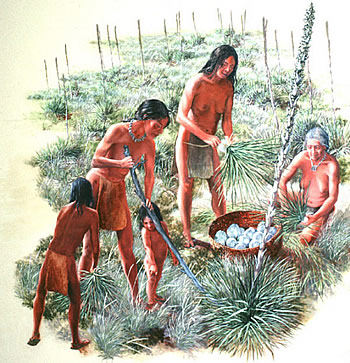 Sotol harvesting as envisioned by artist Nola Davis. (Sotol
bulbs are somewhat larger and less onion-like than depicted.)
Courtesy of the Texas Parks and Wildlife Department.
Sotol bulbs added to the hot rock bed of an earth oven
in the making as envisioned by artist Nola Davis. (Ordinarily,
a layer of green plant material would have been added first
to keep the bulbs from burning, but the finding of numerous
burnt fragments of sotol leaves suggests this step was sometimes
skipped.) Courtesy of the Texas Parks and Wildlife Department.
Cooked lechuguilla could be stored by scraping
off the sugary starches from the leaves and forming a patty
like the one shown here. Such patties are almost pure sugar,
well OK, impure sugar. Dried, these sugar cakes can be stored
for months and even longer. Photo by Phil Dering.
|
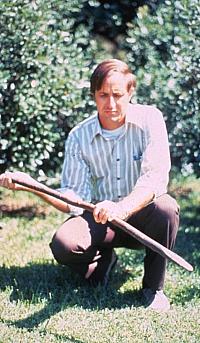
Archeologist Harry Shafer holds a
wooden digging stick found in a dry cave. Digging sticks
were probably the most important tool for Lower Pecos
peoples because they could have served many different
purposes in addition to digging.
|
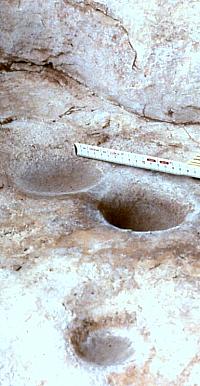
Bedrock mortar holes such as these
are common in the Lower Pecos Canyonlands. Many different foods
require pulverizing, especially hard seeds and seed
pods such as mesquite beans. Photo by Phil Dering.
|
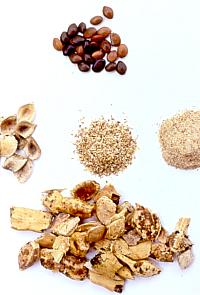
Mesquite bean processing. At top
are the seeds. At the bottom are the pieces of the bean
pods before initial pounding. In the middle row, from
left to right, are the seed husks, the partially pulverized
powder, and the fine mesquite flour. Photo and experimental
work by Phil Dering.
|
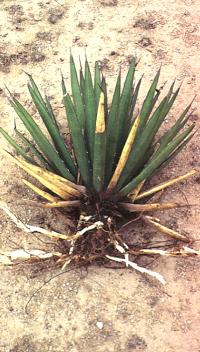
Lechuguilla is one of the smallest
members of the Agave family and one of the most important
plants in the Lower Pecos Canyonlands. Its tough fibers were the
preferred material for making sandals, mats, baskets,
and many other items. Its heart or leaf base was a major
carbohydrate source. Large quantities of lechuguilla
hearts were baked in earth ovens. Recent work has shown
that lechuguilla yields more food than the same amount
of sotol, but that both plants require a tremendous
amount of labor for the return in calories. In other
words, people must have eaten these plants only when
they had no other choice. Photo from ANRA-NPS Archives
at TARL.
|
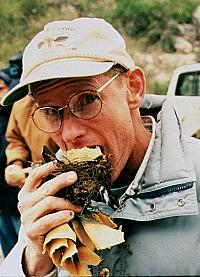
Archeologist and paleobotanist Dr.
Phil Dering chomps into
a cooked lechuguilla heart. Properly cooked, the inner
leaves and base of the plant taste sweet.
|
|